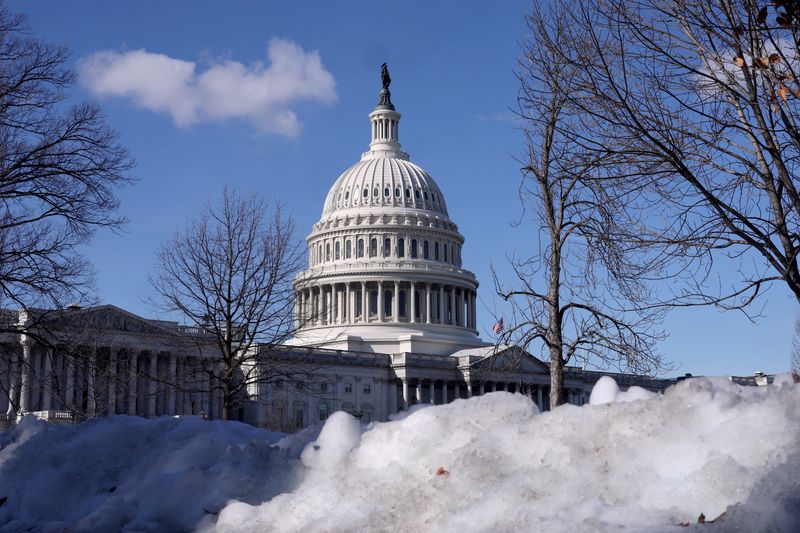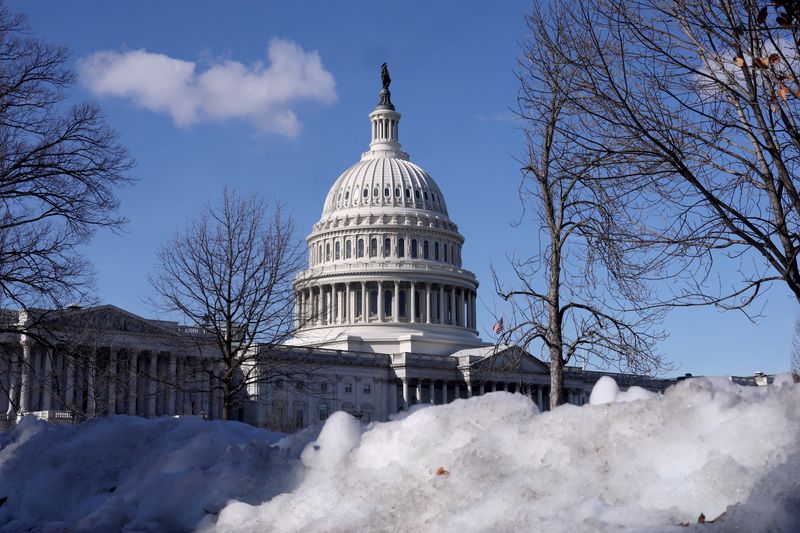
By David Lawder
WASHINGTON (Reuters) – The Congressional Budget Office on Friday forecast a $1.865 trillion U.S. budget deficit for fiscal 2025, largely flat with last year and indicating no major deterioration in government finances before President-elect Donald Trump takes office on Monday.
The CBO “baseline” estimates are based on current laws and assume that Trump’s 2017 individual tax cuts expire as scheduled at the end of this year, causing rates to snap back to higher levels.
Efforts by Trump and Republicans in Congress to extend current individual and small business tax rates could add over $4 trillion to deficits over 10 years if not offset with savings elsewhere. Other tax breaks promised by Trump, such as exempting Social Security, tip and overtime income from taxation, could add more debt.
The CBO data shows that deficits decline slightly to $1.687 trillion, or 5.2% of GDP in fiscal 2027 before gradually rising to $2.637 trillion, or 6.5% of GDP in 2033. The 2026-2035 cumulative deficit is estimated at $21.758 trillion, or 5.8% of GDP.
The CBO’s fiscal 2025 deficit, which equates to 6.2% of GDP, is about $73 billion lower than the non-partisan budget referee agency’s previous forecast for that year in June 2024.
CBO Director Phillip Swagel said the slight improvement in the near-term outlook was largely due to higher revenue projections linked to upward revisions of the CBO’s benchmark estimates of the overall size of the U.S. economy.
“The jumping off point for the size of the economy was higher,” Swagel told reporters. “So even though our economic forecast is reasonably similar to what we had before, the higher jumping off point for the nominal GDP means that there’s more revenue coming in.”
The CBO forecast a slightly slower U.S. economic growth rate, at 1.9% for 2025, compared to 2.0% in the June forecasts, with growth averaging 1.9% over the 2024-2034 window.
NO ‘SUDDEN STOP’
Trump’s pick to lead the U.S. Treasury Department, hedge fund manager Scott Bessent, told senators on Thursday that failure to extend expiring tax cuts this year would cause a massive tax increase that would be an “economic calamity” and cause a “sudden stop” to U.S. growth.
But the CBO forecasts show no abrupt drop-off in U.S. output, with 2025 real GDP growth falling to 1.9% from an estimated 2.3% in 2024, measured on a fourth quarter-to-fourth quarter basis. Growth then hovers at about 1.8% for the rest of the decade, with an average of 1.9% over the 10-year budget window.
Swagel said the steady forecasts reflect an assumption that the Federal Reserve would step in to ease monetary policy, counteracting some of the consumer spending drag from the tax hikes. He also said under CBO assumptions, individuals and businesses will not react immediately on Dec. 31, and will make changes to adjust to the higher tax rates over several years.
The new forecasts also incorporate a much higher cost estimate of $825 billion over the next decade for clean energy tax subsidies associated with President Joe Biden’s signature Inflation Reduction Act. That compares to a $270 billion estimate when the legislation was passed in 2022 and a revised $428 billion 10-year estimate a year ago.
The clean energy subsidies are a key target for Republican budget cutters after Trump takes office on Monday, and Bessent said in his Treasury confirmation hearing that the tax break costs for electric vehicles, battery production, solar power and other sources were “wildly out of control.”
Swagel told reporters that higher cost estimates are due in part to a different budget window, 2025-2035, compared to 2022-2031 when the legislation was first approved. Costs also were higher because of subsequent rule changes that increased the uptake of electric vehicle subsidies, including a leasing provision and new tailpipe emissions standards for internal combustion cars, he said.

